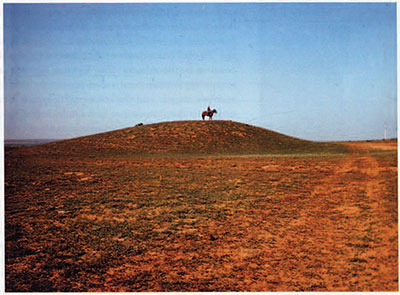
In the broad treeless steppe of Kalmykia, situated almost directly between the Black and Caspian seas, stands a huge burial mound like a great gray rock in a sea of steppe grass (Fig. 1). A field of smaller mounds extends around the giant mound, providing the name of the site, Zunda-Tolga, which means “with one hundred heads.” The burial mounds, or organs, were first constructed almost five thousand years ago by the earliest nomadic groups to live in this area, and the tradition of constructing burial mounds was preserved until the 15th century AD, when Buddhist nomads from Mongolia migrated to and settled this region.
In the mid 1980s an expedition from the State Historical Museum in Moscow, Russia, returned to continue the work of archaeologists who had begun excavating the mounds a century ago. An archaeologist from that museum, Vastly Gorodstov, had identified three major types of Bronze Age kurgans (Gorodstov 1915). The “Yamnaya” is the simplest, consisting of an unmodified pit burial under the mound. The deep pit of the “Catacomb” (catacomb) type features a niche cut into the wall. A third type, the “Scrub,” has a grave constructed with timbers covered by the mound. The Bronze Age of the steppe region can be divided into early, middle, and late stages. and the stages correspond more or less to the three types of burials described by Gorodstov. What we have learned over the course of the last 100 years of research is that these stages also correspond to developments in the use of the steppe during the 3rd and 2nd millennia BC.
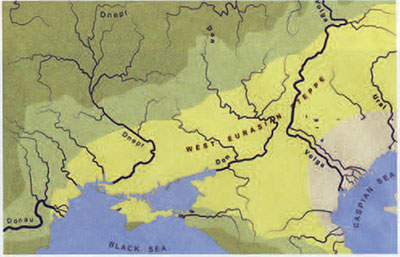
These steppelands represent one of the most extensive ecological zones in the world, stretching from the Black Sea to Mongolia. Archaeologists often consider the steppe to be a vast continuum of grassland pasture which allowed for large-scale movement east-west across Eurasia. However, when we look at it more closely, we see that it is a mosaic of river valleys, steppe grasslands, and highland plateaus. Major rivers such as the Dnepr, the Don, the Volga, and the Ural snake across the grasslands connecting the coastal areas of the Black Sea and Caspian Sea with the forest zone far to the north (Fig. 2). Today, snow-covered pastures characterize the northern steppe zone in winter, and fragile arid-adapted grasses characterize the southern steppe in the summer. Traditionally, the availability of natural resources in this region is best taken advantage of by north-south seasonal movement—a pattern that our new research in Kalmykia allows us to date as early as the 3rd millennium BC (Shishlina 2000).

Our research focuses on determining the various ways that early herders used the steppe. There is evidence of long-distance trade with and borrowing of ceremonial practices from regions to the north and to the south. Bronze jewelry and small tools were brought from the northern Caucasus; and rare dark green porphyrite from the same region was used for maces, symbols of power and high social status. A bone hammer-shaped pin (Fig. 4) is one of the most distinctive tomb objects. Up to 15 such pins, most ornamented with finely carved patterns suggestive of Indo-European snake motifs, have been found in tombs in Kalrnykia.
Yamnaya burial mounds are concentrated along the riverbanks and lake coasts of the Caspian maritime region, in the northern Caucasus, and in the Don, Dnepr, and Volga regions. Within our study region (stretching across the Manych and Chagraika river basins of southern Kalmykia), our GPS (Global Positioning System) survey found early 3rd millennium BC sites only along the lowland river courses and in the surrounding highland plateau region some 40-50 kilometers distant, not out in the open steppelands. We have been investigating local environments by studying ancient natural soils preserved under burial mounds through micromorphology and chemical and botanical remains. Similarly, scientific analyses of materials from the burials themselves have allowed us to determine season of construction and other economic information concerning the time of burial, allowing us to present a picture of the development of early land use.
The Yamnaya Groups
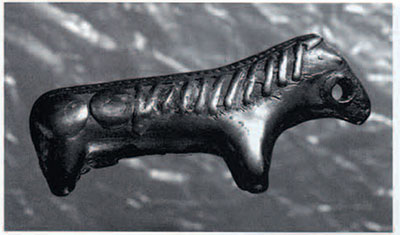
The Yamnaya culture developed during the first half of the 3rd millennium, when there was more rainfall and the area was slightly warmer than it is today (Kremenetsky 1977). The predominate economic indicator of the Yamnaya culture is the presence of herd animals—sheep, cattle, and, for the first time on this part of the steppe, horses. Horses (Fig. 3) allowed groups to resolve the problem of feeding their herds in the snow-covered pastures of the highlands: horses could break the snow cover and the grass remaining underneath was a suitable fodder for sheep and cattle. casus, and in the Don. Dnepr, and Volga regions. Within our study region (stretching across the Manych and Chagraika river basins of southern Kalmykia our GPS (Global Positioning System) survey found early 3rd millennium BC sites only along the lowland river courses and in the surrounding highland plateau region some 40-50 kilometers distant, not out in the open steppelands.
A seasonal difference between lowland and highland kurgan construction and the lack of any evidence for long-term settlements suggest a primarily mobile mode of life. People lived in portable houses, making them warmer with the help of braided mats made of such local plants as reed mace, reed, and wormwood. The Yamnaya people moved predominately along river valleys, and in summer they moved away from the river basins only as far as the nearest highland watershed. exploiting grasslands 20-30 kilometers away from the river. The summer and winter kurgan groups appear to delineate “islands of exploited grassland” in the Kalmykia steppe. The proximity of sets of summer and winter Yamnaya kurgans within Kalmykia is a preliminary indication that these belonged to a single group.
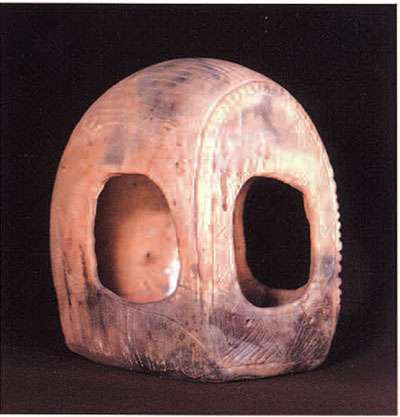
The seasonal pastoral system of Yamnaya herding had allowed them to expand in the first half of the 3rd millennium into this region of steppeland, which had not been occupied by the preceding Neolithic hunter-gatherers. The new adaptation led to population growth, the development of diverse exchanges with neighboring peoples, and gradual social stratification within groups. However, our paleoccological studies of the landscape around the kurgans also suggest that the intensive exploitation of summer and winter grasslands located not far from each other resulted in the destruction of the local grasslands used by the Yamnaya people.
The Middle Bronze Age Katakomb Culture

By the mid-3rd millennium BC, another cultural tradition with an economic organization clearly different from the Yamnaya becomes evident on the Kalmykia steppe. Pastoralists who had more developed north-south trade connections, a more complex social organization, and who buried their dead with great ritual in distinctive catacomb-shaped graves (also beneath kurgans) overlap with the late Yamnaya groups.
Two distinct types of Katakomb kurgan groups were identified, ones characterized by a “central place.” and others which are burial groups which reflect only part of a much larger system. A “central place” has been identified in the Erguni highland region of Kalmykia, where burials were made during all seasons of the year. More common in Kalmykia are organ groups where only spring and summer burials took place. like Zunda-Tolga. Musharet, and Manjik-my. The winter pastures (and organs) appear to be located some 100-300 kilometers to the south and southeast, in the climatically less severe steppe north of the Caucasus. Thus, the Katakomb groups appear to have been much more mobile than the earlier Yamnaya groups. They expanded across a wide area of the Kalmykia steppe, into regions not previously marked with kurgans: the open steppe along the Caspian lowlands, and to the north in the valleys of the Don and Volga. The break into the open steppe was a successful implementation of the new nomadic herding economy.
Like the earlier Yamnaya culture, sheep, goats, and cattle constituted the main herd animals. During the Katakomb period, the cows and goats appear to have been more extensively used for production of milk and milk products (Fig. 5), and horses were used as mounted animals and for pack transport. The bow and arrow first appear on the steppe at this time; although hunting occupied a much smaller component of the economy, lynx, wolf, and saiga bones have been found in the burials.
The best preserved catacomb graves (Fig. 6) offer tantalizing aspects of this new mobile way of life: reed mat imprints on the clay walls and floor suggest that the tomb imitated the interior of a yurt or wagon. The body was carefully laid in the niche with numerous goods (bronze jewelry, foodstuffs, and tools), then the entrance to the chamber was closed with a wagon wheel or a wooden door. Often, a wagon or its clay model was placed into the entrance pit (Fig. 7). The presence of pottery vessels containing charcoal of aromatic boxwood in such tombs suggests a complex funerary ritual, and the numerous food remains, hearths, and debris found within construction levels of the organs indicate funerary feasts probably took place. Burials of ordinary people were not so elaborate, but even they astonish us with their abundance of burial goods.
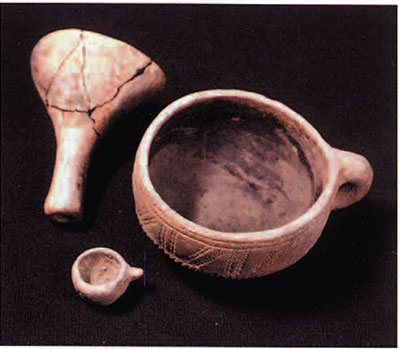
The first looms are likely to have appeared in the steppe at this time. The Katakomb people used wool as well as locally available fibers of reed mace, reed, and hemp. Sheep breeding expanded in order to produce enough wool for textiles, and the diversity of spindle whorls indicates that both coarse and fine threads were spun. Imprints of cloth on pottery and rare instances of preserved textiles themselves dem onstrate that both vertical and horizontal looms were used to make narrow cloth, braid and rope, and other textiles. Such goods would have been in high demand among nomads. Wool rope and braid are stronger than those made of vegetable fibers and would have been critical for the assembling of Bronze Age yurts. Kalmyks who lived in these steppes in the 19th century needed several dozen meters of wide braid and rope to fasten the wooden framework and large felt mats of one yurt.
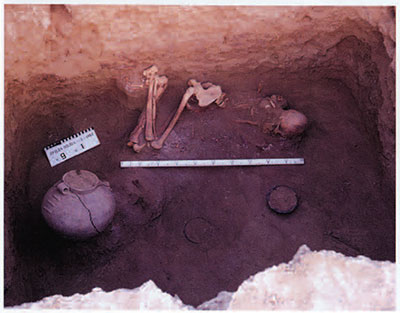
Hundreds of kurgans uncovered in the Chograi and Manych valleys have yielded numerous goods not solely of steppe origin, but also from the Caucasus region (Shishliria 1977). The area south of the Caspian lowlands could have been a trade and cultural center as early as 3000 BC. Most likely, the Caucasus agriculturalists exchanged metal ingots, finished bronze jewelry and tools (Fig. 8), ceremonial axes of rare stone, ceramics, cloth, and agricultural products like wheat for steppe products such as skins, leather goods, livestock, and horses. A whole sackful of wheat—including both emmer and einkorn—has been found in one of the Katakomb burials in the Crimea. Boxwood that was found in Katakomb tombs does not grow and has never grown in the steppe, so it probably was brought from the Caucasus region where it naturally occurs.
Implications of Steppe Archaeology
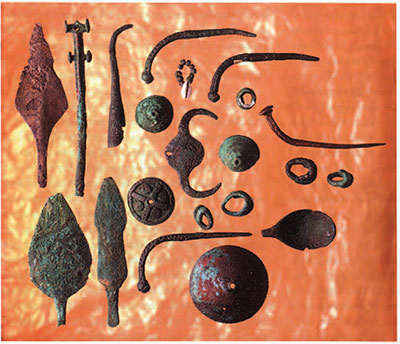
The cultural developments of the Yamnaya and Katakomb groups were accompanied by complex, new ideological constructs. The expansion of cultural, trade, and economic links resulted in the incorporation first of symbols and then of rituals characteristic of adjacent territories. For example, snake images—a component of early Indo-European symbolism—appear in steppe art at the beginning of the 3rd millennium BC during the Early Bronze Age. Drawings portraying snakes appear on clay dishes and ceremonial pins, and snake skeletons have been found in Yamnaya and Katakomb tombs. A gold pendant in the form of a snake biting its tail probably decorated the forehead strap of the woman buried in the Yergueni (Katakomb) site in Kalmykia (Fig. 9). Perhaps the snake coiled up into a ring embodied the idea of the seasonal cycle of movement and of periodic renewal for the steppe people.
During the Late Bronze age (the mid-2nd millennium BC), the first horse-drawn chariots appear (Fig. 10). Distinctive burials of craftspeople-potters, metalworkers, and woodworkers—indicate that the herding cultures had become socially and economically stratified. Katakomb-type cultures stretched from the Black Sea coast to the Ural mountains, occupying a wide diversity of grassland and forest-steppe environments. By the late 2nd millennium BC, Katakomb groups in the European part of the Eurasian steppe, particularly those living in such fertile regions as the Black Sea maritime steppes, practiced a complex, combined agricultural and herding economy. This resulted in the population becoming more sedentary. Thus, in the steppe zone of the southern Ukraine and in the Crimea, more permanent Katakomb settlements have been found along steep bedrock banks of major rivers.
The Katakomb people who lived near deltas of large rivers or near the sea coasts may have been engaged in fishing, though fishing, like gathering wild plants, played less of a role than herding in their economy. Nomadic groups living in the eastern part of the west Eurasian steppe preferred to breed domesticated animals, but also functioned as intermediaries in the interregional trade between the Caucasus and the steppe. The largest amount of metal jewelry and weapons from the northern Caucasus region has been found in the Caspian maritime steppe, and it is possible that the Katakomb populations living in this region controlled trade routes or were merchants themselves.
Conclusions
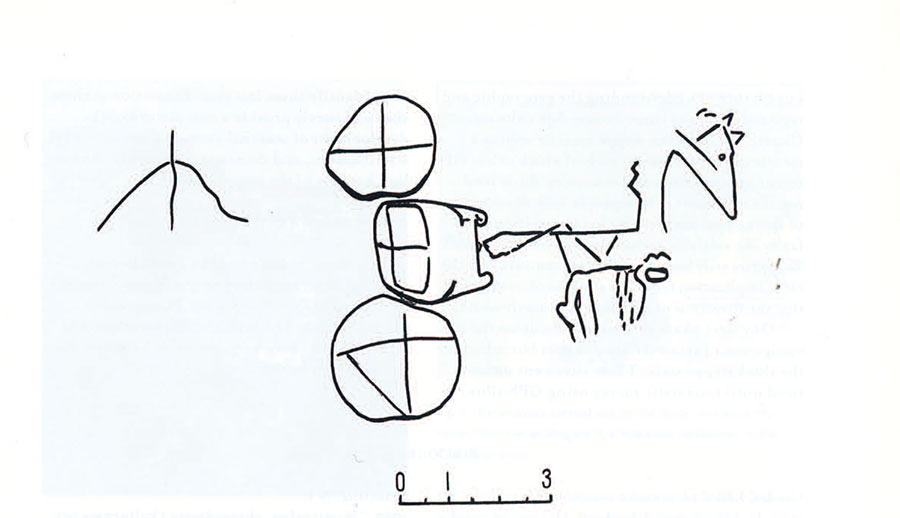
Our research has just begun to show the complexity of early land use on the Eurasian steppe. Differences in seasonal land use, the identification of items for production, consumption, and trade, and the specialized nature of animal husbandry on the steppe point up the importance of understanding the geographic and regional setting of these Bronze Age cultures. Clearly, the Eurasian steppe must be seen as a mosaic of environments, each of which offers different opportunities and resources. Early land use is a reflection of how people took advantage of these opportunities. We have been limited so far by the available archaeological remains, which have primarily been from burial contexts, but the clear implication from the analysis of our data is that the direction of interaction is north-south.
Our next phase of work will focus on the investigation of small settlement sites buried under the thick steppe soils. These sites went unnoticed until systematic survey using GPS allowed us to identify them last year. Excavation at these sites will surely provide a new picture of the development of seasonal economic cycles, social stratification, and domestic economy of the earliest herders of the steppe.
Gorodtsov, V.A. 1915. “Kultury bronzovoy epochi v sredney Rossii.” In Otchet Imperatorskogo Muzeya v Moskve. Moscow.
Koltsov, P.M. 1985. “Noviye pamyatniki neolita i eneolita Chernykh zemel.” In Drevnosti Kalmykii. Elista: Institut
Arkheologii Akademii Nauk SSSR.
Kremenetsky, K.V. 1997. “Prirodnaya obstanovka golotsena na Nizhnem. Dony i v Kalmykii.” In Steppe and the Caucasus (Cultural Traditions). Trucdy Gosudarstvemogo Istoricheskogo Muzeya, vol. 97, PP· 30-46. Moscow.
Shishlina, N.I. 1997. “Stratigrafiya, chronologiya i kulturnaya prinadlezhnost kurgana I mogilnika Zunda-Tolga.” In Steppe and the Caucasus (Cultural Traditions). Trudy Gosudarstvemogo Istoricheskogo Muzeya. vol. 97, pp. 81-92. Moscow.
1998. “0 zmee v mifologicheskikh predstavleniyakb stepnikh kochevnikov epokhi bronzi.” In Arkheologicheskii Sbornik. Moscow: GIM.
Shishlina, N.I., ed. 2000. “Seasonality Studies of the Bronze Age Northwest Caspian.” In TrucJy Gosudarstvemogo Istoricheskogo
Muzeya, vol. 120. Moscow.
Sinitsyn, I.V., and U.E. Erdniyev 1978. Drevnosty vostochnogo Manycha. Saratov.
